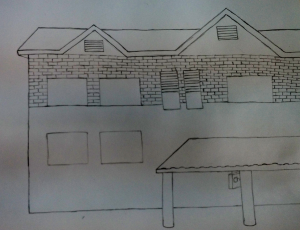Once I finally arrived at the airport in Entebbe, I made my way through customs and collected my luggage. I then took a taxi to the house I am staying in for my first two weeks in Kampala. It was already dark when I landed but I still tried to take in as much as I could on to drive to Kampala.
As we progressed along the Kampala-Entebbe road, I was able to catch glimpses of the Friday night nightlife. Along the road there were many clubs, restaurants and many other locations playing music. As we drove, I would hear just a small clip of sound from each one. Coincidentally, the room I am staying in is right next to a club. However, three of the first songs I heard before I went to sleep (I was way too tired to try and go out after the trip) were ‘We Found Love’ by Rihanna, ‘Waka Waka (This Time For Africa)’ by Shakira and ‘Drunk in Love’ by Beyoncé.
One of my first observations on the next morning was how different the soundscape is here. In addition to the club next door the night was filled with the sound of barking dogs. The morning was filled with a variety of beautiful bird songs as well as the sound of roosters welcoming the new day with a cockadoodledoo.
The earth here is also distinct. It is a deep brick orange that contrasts beautifully with the luscious greens of the vegetation. Amongst the trees and other plants I have also caught glimpses of various birds including a vibrant flash of red and blue swooping briskly from one tree to another. I plan to find a book on the flora and fauna of Uganda so I can learn more about what I am seeing. There is also a balcony overlooking the beautiful garden of the house I am staying in. I hope to spend some of the sunny afternoons reading and birdwatching from there.
Even though I have been here a few days I am still getting the feel for navigating the city. Part of the difficulty is that the streets aren’t organized on any easily discernible grid. This however is understandable as the city is built entirely on hills so the roads tend to curve up and around the hills. Kampala was originally built on 7 hills and was the center of the Baganda kingdom. It has now spread onto the surrounding hills as well. I am staying with a family friend, Cathy, on Kololo Hill. Fortunately, this is close to both Makerere University and the National Theater.
On my second day in Kampala, Cathy introduced me to her friend Denis. Denis first showed me two shopping centers in walking distance from where I am staying just in case I need to pick up anything while I am here. From there we walked to the National Theater and took a look around. At the National Theater I was able to get a list of scheduled events which will definitely be convenient during my stay. From there we walked to a taxi stop and took a Matatu (minibus) to the Shell station in Bugolobi. From there we walked a short distance to Gattomatto and Jazz Ville. These are two venues that Denis said would be good for hearing live music while I am in Kampala. From there we took another Matatu to another venue called Zone 7 in a neighborhood called Nakawa. Next we went to Ntinda to go to the Ndere Center to see the Ndere Troupe perform.
The Ndere Center was a wonderful experience. The NdeMolly, another of Cathy’s friends, met us there. She is a dancer and was able to explain the dances, music and musical instruments. The dancers performed dances from all over Uganda as well as a few dances from Rwanda and Burundi. One of the goals of the Ndere Troupe is to promote unity through the inclusion of dance and music styles from a diverse group of people.
A passage from Waiting by Goretti Kyomuhendo highlights the diversity of cultures found throughout East Africa. The narrator of the story is from a district of Uganda called Hoima. The majority of the people in Hoima speak Nyoro which is the language of the Banyoro people. In this passage she is talking to one of her friends about the Tanzanian army that is passing through their town while attempting to drive Idi Amin’s army out of Uganda:
“But what about their own languages? I mean, the languages of their tribes?”
“They don’t speak them.”
“Then how can they tell what tribe someone belongs to?”
“I’m sure it must be difficult since everyone speaks the same language. Maybe they can tell by their names, you know, just like here; people from different regions have different names.” (82)
The language the Tanzanian soldiers speak is Kiswahili. Kiswahili is primarily a Bantu language from the east coast of Africa (Kenya, Tanzania and northern Mozambique). However due to the cultural integration with Arab trader it also contains a large Arabic influence. Kiswahili is considered a lingua franca for much of East Africa including Kenya, Tanzania, Mozambique, Uganda, The Democratic Republic of Congo, Rwanda and Burundi. In Kampala a large percentage of the population speaks English as it is the official language of Uganda. However, walking around the city it is easy to hear a wide variety of languages including Luganda (Kampala was originally the center of the Baganda Kingdom) and Kiswahili.





